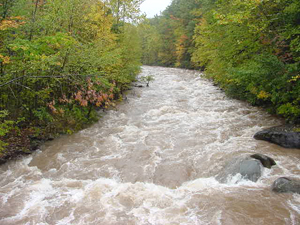Why are Catskill Mountain Streams Important?
This page contains an introductory lesson about stream and floodplain processes and functions. Below are brief summaries with more detailed information in the links provided.
Our Catskill streams are more than aesthetic wonders and resources for recreation. They perform important environmental functions and services, including providing the lifeblood of countless organisms – including humans, plants and animals – to draining floodwaters and moving rock and soil eroded from the mountains to build fertile valleys. These functions are complex and interrelated. The stream is a dynamic feature of the landscape, ready to swell in a heavy rainstorm or shrink to a trickle during a drought. Understanding these relationships is vital to well-informed living near our streams.
Water in Motion
Streams drain the landscape. When rain falls or snow melts, water that doesn’t seep into the ground becomes runoff. This runoff drains into a network of streams, brooks, creeks and rivers. Along this network, stream channels shape themselves to carry the high water of spring snow melt. Flows that exceed the stream channel’s capacity become floods, which can range from minor events to raging torrents that carve new channels. The floodwater is routed down the valley across the floodplains, which play an important role in a watershed’s drainage system. By dissipating the water’s erosive energy, floodplains help keep stream channels stable and able to carry regular daily flows.


